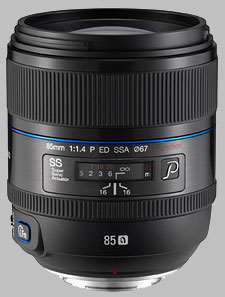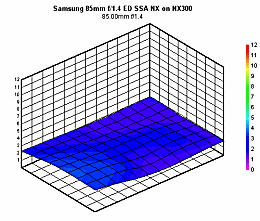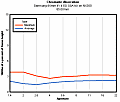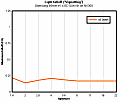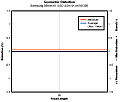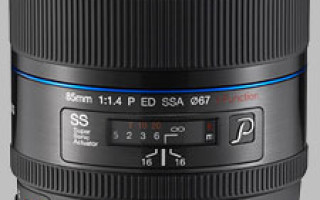Обзор объектива Samsung NX 85mm f/1.4 ED SSA
Обзор объектива Samsung NX 85mm f/1.4 ED SSA
Компания Samsung была одной из первых, кто вывел на рынок беззеркальные камеры. С тех самых пор продолжается выпуск новых объективов, которые весьма интересны своими характеристиками. В сегодняшнем обзоре будет представлен объектив Samsung NX 85mm f/1.4 ED SSA. Это классический портретник. С точки зрения некоторых характеристик он аналогичен объективу 125/2.0.
Технические характеристики NX 85mm f/1.4 ED SSA
- Байонет: NX Samsung.
- Фокусное расстояние: фиксированное — 85 мм.
- Светосила: f/1.4.
- Наименьшая диафрагма: f/22.
- Количество и тип лепестков: 10, скруглённые.
- Линзы: 10 линз, 8 групп.
- Мотор фокуса: ультразвуковой — SSA (SuperSonic Actuator).
- Шкала фокусировки: есть.
- Ручная доводка фокуса: есть.
- Наименьшая дистанция фокусировки: 0.82 м.
- Максимальный масштаб: 0.13х.
- Габариты и масса: 92 мм х 79 мм, 714 грамм.
Внешний вид и конструктив
Samsung NX 85/1.4 является довольно солидным объективом. Корпус у него выполнен из металла. Кольца для фокусировки и i-Function имеют прорезиненное покрытие и плавный ход. Передняя линза в диаметре составляет 67 мм. Качество сборки объектива в целом превосходное. Стоит обратить внимание на то, что NX85/1.4 имеет шкалу расстояний, переключатель режима фокуса (автомат и ручной), а также кнопку i-Function.
Наибольшее впечатление производит размер объектива. Это устройство довольно забавно смотрится на компактных, небольших камерах линейки NX.
При тестировании объектива с камерой NX200 он показал себя не с лучшей стороны. Устройство постоянно переклонялось вперед. Кадрирование с этим объективом затруднительно из-за отсутствия стабилизации. можно предположить, что на более крупных камерах он будет вести себя намного лучше. Например, NX 20 смотрелось бы с этим «Стеклом» намного лучше.
Автофокус
Объектив Samsung NX 85/1.4 оборудован ультразвуковым мотором для фокусировки. Подстройка фокуса происходит совершенно без шума, но при этом происходит это слишком медленно. Связано это с большой массой механизма фокусировки, и с маленькой глубиной резкости, что в свою очередь требует высокой точности при наводке на резкость. Доводку фокуса можно производить вручную без переключения в ручной режим.
С устройством NX200 объектив NX 85/1.4 показал не самые лучшие показатели точности фокусировки.
Качество изображения
NX 85/1.4 создает очень хорошие и качественные снимки. Качество изображения на отличном уровне. Объектив имеет отличное разрешение даже при открытой диафрагме, но контраст при этом сильно снижается. Это происходит из-за сферической аберрации. Действительно резким объектив можно назвать с диафрагмы f/2. В целом, это больше относится к светосильной оптики.
Приятной особенностью объектива NX 85/1.4 является мягкий характер зон нерезкости. Плавное размытие заднего плана достигается благодаря скругленным лепесткам диафрагмы.
Выводы напоследок
Бесспорно, объектив NX 85/1.4 ED SSA выступает лидером в линейке оптики Samsung NX. Качественная сборка и материалы, высокое разрешение и мягкое размытие — это те качества, которыми он явно выделяется среди конкурентов.
Также, приятный нюанс объектива — это его цена. Розничная стоимость устройства составляет 840 долларов. Это в два раза дешевле аналогичных оптик от Nikon и Sony.
Возможно, Samsung NX 85/1.4 ED SSA является приманкой для привлечения пользователей к технике Samsung, а именно линейке NX.
4 причины для покупки NX 85/1.4:
- отличное, качественное разрешение;
- приятное размытие заднего плана;
- бесшумный автофокус + поддержка FTM;
- превосходное качество сборки и состав материалов.
1 недостаток Samsung NX 85/1.4 ED SSA:
- низкая скорость и не высокая точность автофокуса.
Samsung 85mm f/1.4 ED SSA NX
| 85mm | $1,000 average price |
||||||
|---|---|---|---|---|---|---|---|
Chromatic aberrations are very well controlled, with extremely low levels recorded at wider apertures. This low level of CA increases as the aperture is stopped down, but still doesn’t reach the point where fringing may be too much of an issue, even at f/16.
Falloff of illumination towards the corners is incredibly well controlled for a lens with such a bright maximum aperture. At f/1.4 the corners are only 0.524 stops darker than the image centre and visually uniform illumination is achieved with the lens stopped down to f/2.
Very little distortion is present in images taken with this lens. Imatest could only detect 0.51% pincushion distortion. The distortion pattern is uniform across the frame, which should make applying any corrections in image editing software a straightforward affair.
Contrast is good with this lens although shooting results in a visible reduction. Light sources just outside the frame can cause flare quite easily if the supplied hood isn’t used, so it is probably a good idea to leave it attached at all times.
Samsung NX 85mm f/1.4 ED SSA Sample Photos
Value for Money
Samsung currently have a virtual monopoly on lenses for their NX system, as there are very few third party manufactures producing lenses for their cameras. This lens is available for around £800, which certainly isn’t cheap, but is quite reasonable for an 85mm lens with an f/1.4 maximum aperture.
Samyang currently produce a manual focus 85mm f/1.4 lens, which can be picked up for around £240, which is certainly a lot cheaper if you can live without the convenience of autofocus.
Samsung 85mm f/1.4 ED SSA NX Verdict
The sharpness this lens delivers is excellent, and although the price may be high when compared to other Samsung NX lenses, it isn’t when compared to 85mm f/1.4 lenses from the likes of Nikon or Sony.
Those looking for an excellent quality telephoto lens for their NX system camera, ideally suited for low light shooting and for creating shallow depth of field effects, as you may do when taking portraits, might not have that many options to choose from. However, this lens should certainly not be overlooked.
 |
| The Samsung 85mm f/1.4 lens has good sharpness at the maximum aperture, and is excellent when stopped down. |
Samsung 85mm f/1.4 ED SSA NX Pros
 Good sharpness at maximum aperture
Good sharpness at maximum aperture  Excellent sharpness when stopped down
Excellent sharpness when stopped down  Good build quality
Good build quality  Low chromatic aberration
Low chromatic aberration
Samsung 85mm f/1.4 ED SSA NX Cons
 May be too bulky for the most compact NX system cameras
May be too bulky for the most compact NX system cameras  Can be prone to flare
Can be prone to flare
Обзор Samsung NX300
Качество снимков — разрешение

Тест разрешения выполнен с использованием специальной тестовой мишени. Баланс белого по образцу, экспокоррекция +2/3EV. Снимки сделаны в JPEG максимального качества. Красными рамками обозначены участки изображения, которые далее будут приведены в увеличенном масштабе.
Двузначные числа на последующих кропах указывают количество линий (х100), приходящихся на полную высоту кадра. Например, 24 означает 2400 линии на всю высоту кадра.
Обычно мы отмечаем розовой полоской теоретический максимум разрешения, который способна обеспечить камера с учетом количества пикселей в ее матрице по короткой (вертикальной) стороне. В Samsung NX300 используется матрица разрешения 5472х3648 точек, и это значение составляет 3648.
Поясним чуть подробнее. Представьте себе очень примитивную матрицу, размером всего 10х10 пикселей. Такая матрица в лучшем случае сможет «разрешить» десять линий – то есть, сформировать изображение, на котором можно будет различить десять раздельных линий (считаются как черные полосы, так и белые промежутки между ними), но не более того. Аналогично, теоретический максимум для Samsung NX300 составляет 3648 линий. На практике значение получается меньше – свой вклад вносит и неидеальность объектива, и шумы матрицы, и другие факторы – так что разрешения уровня 3600+, а с ними и розовая полоска, оказываются за рамками наших иллюстраций.
Мы делали тестовые снимки тремя объективами: Samsung 18-55/3.5-5.6 OIS III (при фокусных расстояниях f=22 и f=48 мм), Samsung 45/1.8 2D/3D и Samsung 85/1.4 ED SSA при разных значениях диафрагмы.
Объектив Samsung 18-55/3.5-5.6 OIS III при f=22 мм (33 экв.мм):

Фрагменты тех же снимков с горизонтальным расположением линий растра:

Объектив Samsung 18-55/3.5-5.6 OIS III при f=48 мм (73 экв.мм):

То же, горизонтальные линии:

Объектив Samsung 45/1.8 2D/3D в режиме 2D (69 экв.мм):


Наконец, объектив Samsung 85/1.4 ED SSA (130 экв.мм):


Мы стремимся представлять результаты в максимально наглядном виде, поэтому надеемся, что вас все хорошо видно из иллюстраций – и разница между объективами, и как зависит резкость от изменения диафрагмы.
Хочется отметить объектив Samsung 85/1.4 ED SSA, который дает прекрасную картинку при не такой уж высокой стоимости. Оптимальной при его использовании как портретника, вероятно, будет район диафрагм F/4, где он обеспечивает и максимальную резкость, и достаточно сильное размытие фона. Более открытые диафрагмы дают менее резкую картинку, зато способны придать объем снимкам, разделив планы, которые для большинства объективов будут просто «бесконечностями». Сравните два снимка, сделанные с диафрагмами F/5.6 и F/2. Расстояние до корабля, насколько я могу судить из Яндекс Карт – около 100 метров. По клику загружаются полные файлы 12 МБ.
 |
 |
| Режим Аv, ISO100, f=130 экв.мм, F/5.6, 1/500 | Режим Аv, ISO100, f=130 экв.мм, F/2.0, 1/2500 |
Немного жаль, что объектив Samsung 85/1.4 ED SSA не имеет оптической стабилизации, все таки при 130 эквивалентных миллиметров она была бы желательно. Хотя, конечно, отчасти это компенсируется высокой светосилой объектива, и уж в солнечную погоду выдержки точно будут достаточно короткими.
Заметим, что коэффициент фокусного расстояния для системы Samsung NX принято считать равной х1.5, так что фокусное расстояние 85 мм должно бы соответствовать эквивалентным 85х1.5=127.5 экв.мм, однако в EXIF камера пишет именно значение 130 экв.мм, которое мы и используем. Исходя из этого, более точное значение коэффициента составляет х1.53.
Следующие снимки, сделанные при ISO 100, 400, 1600, 6400 и 25600, показывают, как повышение ISO влияет на разрешающую способность камеры.
Samsung NX 85mm F1.4 ED SSA Lens Review

Having waited months since its availability in Singapore, I finally got a review unit together with the Samsung NX20 last week.

At 696g, it’s huge and heavy compared to the lightweight NX body – even the heaviest NX11 weighs only 353g. With a minimum focal distance of 0.82m, you can’t use it for close-up shots like my favourite 60mm f2.8 MACRO lens. Focusing speed is not very fast but silent. You can override auto-focus anytime by turning the focusing ring.
 |
| The 85mm lens is huge and heavy compared to the latest Samsung NX20. |
The lens is better in its overall build and optical performance compared to the Nikkor 85mm f1.8 AFD I owned. Less fringing at large aperture, less haze effect when shooting against light, and certainly much sharper. From the photos taken with it, many people liked the bokeh, i.e. the blurness of the out-of-focus background.


More photos of my friend here.
Another set of photos taken with another friend.


Check out the shallow depth of field from the below photos:


What you notice is that the lens focuses sharply at the tip of the eyelashes. The eye ball, despite a mere millimetre difference away, is clearly out of focus.
How would a normal kit lens like 18-55mm f3.5-5.6 compare with this 85mm f1.4 portrait lens? Here’s your answer.

See the background blur? That’s bokeh.

The NX 85mm f1.4 is the most expensive lens among the NX lens, but it is certainly worth it. A camera is useless if the lens does not help you capture the images you want. A slow lens (small aperture) will reduce shutter speed and potentially make your handheld images blur. The 85mm f1.4 is the brightest lens in the Samsung NX line-up. If you love to capture powerful portrait images, then this lens will give you the shooting edge.
Samsung 85mm f/1.4 ED SSA i-F Review
Key Specifications
- Review Price: £620
In the days of 35mm film photography, many professionals chose either 85mm or 135mm lenses for portraiture. Samsung’s new NX-mount 85mm prime has the same angle-of-view as a full-frame 130mm lens and it is therefore unsurprising that the company’s launch press release described its 85mm as a premium portrait lens.
Sadly, an appropriate focal-length is not sufficient to justify such a grand claim: fortunately, Samsungs new lens has much more to shout about than this alone. Most importantly, it offers an ultra-fast f/1.4 maximum aperture setting coupled with quick and quiet auto-focusing that permits full-time manual adjustments. It also looks and feels very solid, immediately inspiring confidence in its handling and durability.
The broad manual-focusing ring is located towards the front of the lens and offers just the right amount of resistance across its approximately 100-degree throw. Manual focusing can be applied in AF mode and activates a magnified view to make critical adjustments easier to apply. There is also a purely-manual focusing mode that is most likely to be used when photographing static subjects under difficult conditions.
To the rear of the focusing ring is a focused-distance window, complete with depth-of-field markings for f/22, behind which sits Samsung’s incredibly useful i-Function collar. An i-Function activation button and a focussing-mode selector complete the lens controls. The obvious omission is any form of image stabilisation technology.
As well as a protective pouch, Samsung has included a generous hood with the lens but its surface finish is so slippery that there is a real danger of the lens being dropped if grasped by the hood. This is equally important whether the hood is fitted for use or reversed over the lens for storage, in which case it hides the entire barrel except for the two buttons at the very rear. In short, the lens hood is both a liability and an inconvenience so might usefully be put to one side.
Technical testing produced a very impressive MTF curve that remained above the critical 0.25 cycles-per-pixel level right across the aperture range save for the final one-third of an F-stop. Peak resolution occurs at f/4, achieving a remarkable 0.4 cycles-per-pixel. There was only the faintest hint of chromatic aberration on the high-contrast test target and no signs in any of the real-world photographs, which exhibited excellent visual sharpness. Taken together, these results justify a maximum 20/20 score for image quality.
The sheer size of Samsung’s 85mm f/1.4 prime means it dwarfed the NX200 body used for this review: there is also a potential issue when using a tripod as the lens barrel extends below the camera’s base-plate, making it difficult (but not impossible) to seat a large tripod plate squarely.
There is also a case for saying that a lens of this size and mass is better suited to use with a viewfinder body (such as the Samsung NX11) rather than the NX200 used here.
Sample images



Verdict
The slippery lens hood is annoying and the lack of image stabilisation is an omission that some users may resent but this is an excellent lens in its own right and truly is, as Samsung claims, a premium portrait lens that is worth of very serious consideration.
Trusted Score
Unlike other sites, we thoroughly test every product we review. We use industry standard tests in order to compare features properly. We’ll always tell you what we find. We never, ever accept money to review a product. Tell us what you think — send your emails to the Editor.
Samsung 85mm f/1.4 ED SSA NX



Описание
Samsung 85mm f/1.4 ED SSA NX — это единственный, в своем роде, компактный телеобъектив объектив со светосилой F/1.4. В объективе есть режим ручной фокусировки, для более комфортного использования и для тех, кто любит экспериментировать. Вы можете установить выдержку, диафрагму и другие параметры, простым поворотом кольца на оправе объектива. Samsung 85mm f/1.4 ED SSA NX создан как для любителей, так и для профессионалов. Удобный объектив, с поддержкой i-Function, будет отвечать всем Вашим требованиям.
Объектив, 2 защитные крышки (передняя, задняя), бленда.
Производителем могут быть изменены комплект поставки и страна производства без предварительного уведомления, вследствие чего на момент продажи конкретного товара они могут отличаться от указанных ранее.
Гарантия
Гарантия на товар — 2 года. По вопросам гарантийного обслуживания вы можете обратиться в наш магазин или в официальный сервисный центр производителя.
Товары со скидкой
С этим товаром часто смотрят

Пользователи также смотрят

В данный момент отзывы о товаре отсутствуют. Вы можете стать первым .
В данный момент вопросы о товаре отсутствуют. Вы можете стать первым .

- Астрахань
- Барнаул
- Брянск
- Владивосток
- Волгоград
- Воронеж
- Екатеринбург
- Иваново
- Ижевск
- Иркутск
- Казань
- Калининград
- Кемерово
- Киров
- Краснодар
- Красноярск
- Курск
- Липецк
- Магнитогорск
- Махачкала
- Москва
- Набережные Челны
- Нижний Новгород
- Новокузнецк
- Новосибирск
- Омск
- Оренбург
- Пенза
- Пермь
- Ростов-на-Дону
- Рязань
- Самара
- Санкт-Петербург
- Саратов
- Тольятти
- Томск
- Тула
- Тюмень
- Улан-Удэ
- Ульяновск
- Уфа
- Хабаровск
- Чебоксары
- Челябинск
- Ярославль
- Винница
- Днепропетровск
- Донецк
- Житомир
- Запорожье
- Киев
- Кривой Рог
- Луганск
- Львов
- Макеевка
- Мариуполь
- Николаев
- Одесса
- Полтава
- Севастополь
- Симферополь
- Харьков
- Херсон
- Черкассы
- Чернигов
- Актобе
- Алматы
- Астана
- Караганда
- Костанай
- Павлодар
- Тараз
- Уральск
- Усть-Каменогорск
- Шымкент
Вы можете купить Samsung 85mm f/1.4 ED SSA NX в нашем интернет-магазине, заказав доставку курьером на удобное для вас время.

